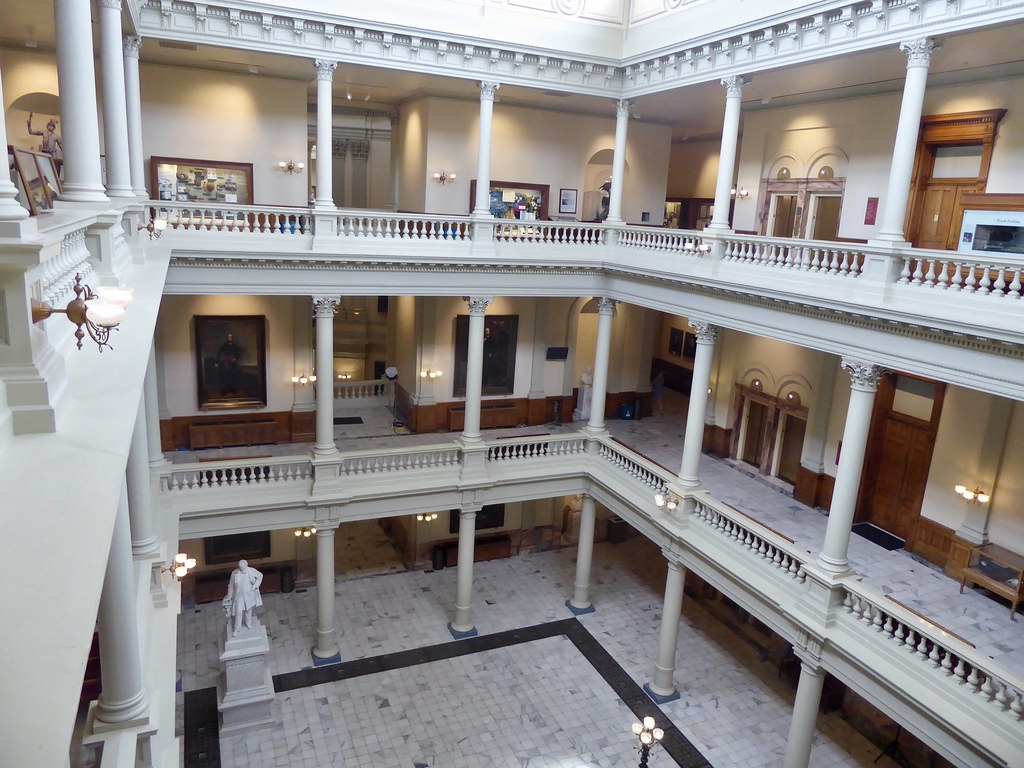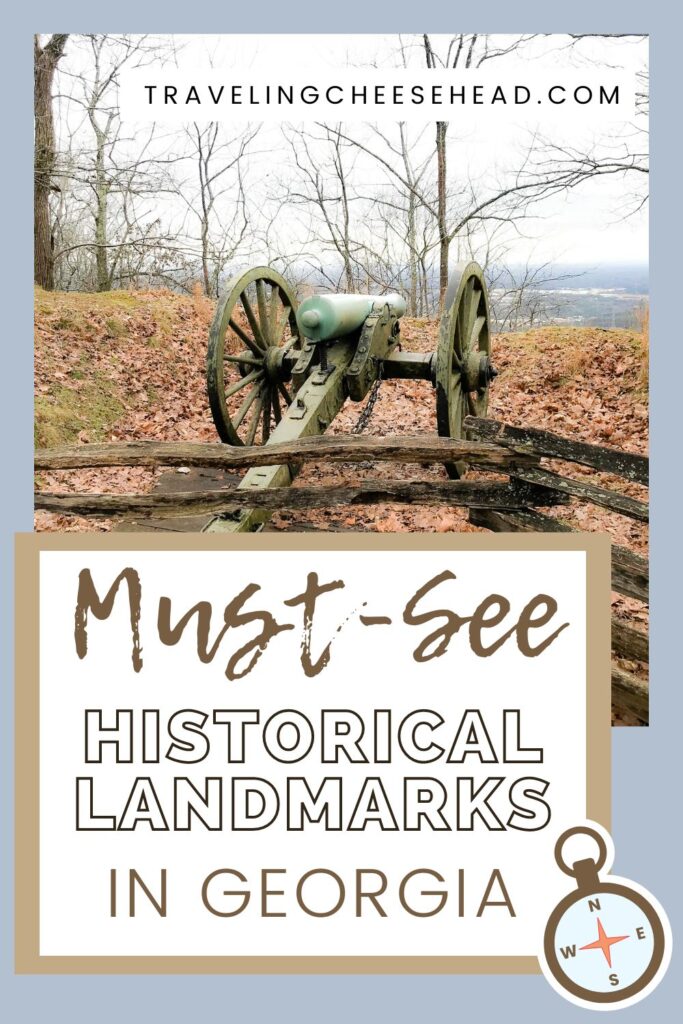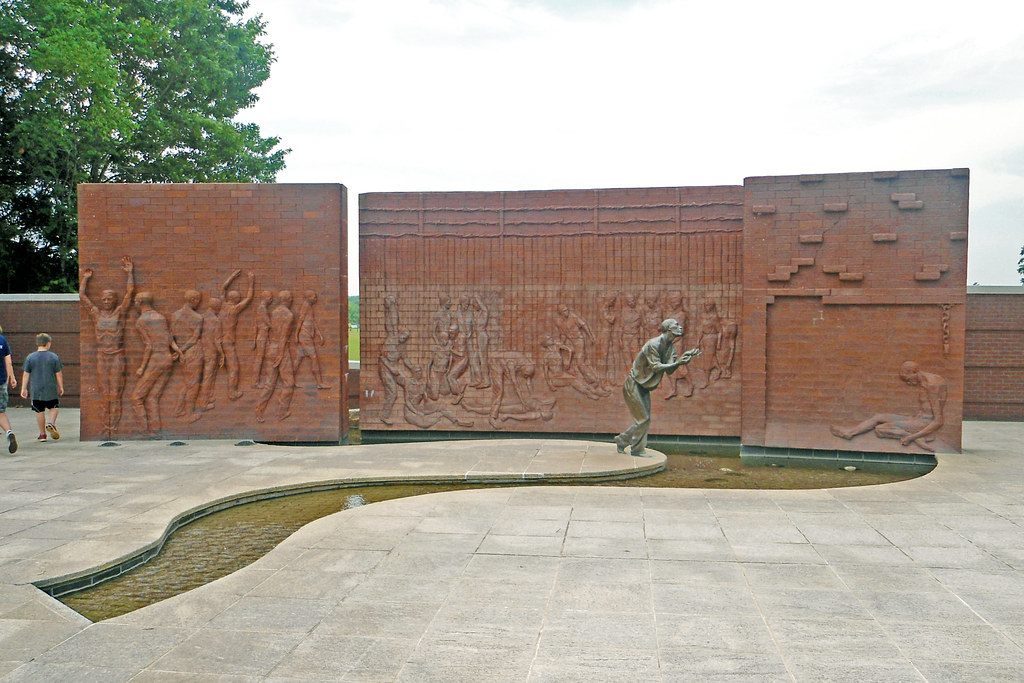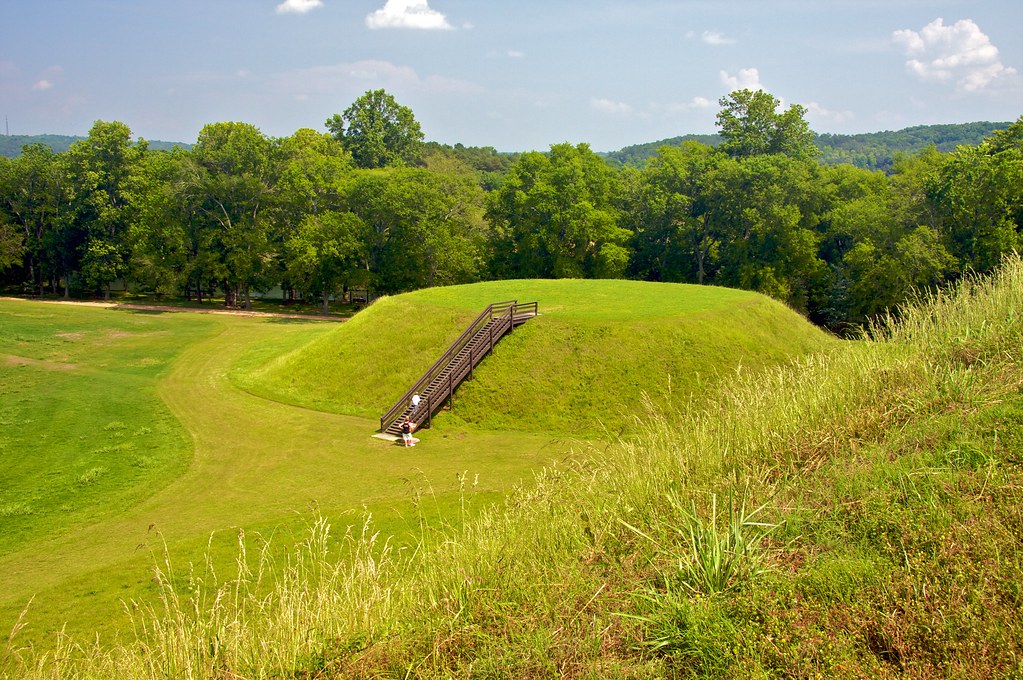
We may earn money or products from the companies mentioned in this post. This helps support what we do and in no way costs you a thing.
If you’re planning a trip to Georgia, you won’t want to miss the state’s must-see historic landmarks. Georgia is filled with rich history, from the Civil War to the Civil Rights Movement, and there are plenty of must-see sites that will transport you back in time. Whether you’re a history buff or just looking for a unique experience, Georgia’s historic landmarks are sure to impress.

One of the most famous historic landmarks in Georgia is the Martin Luther King Jr. National Historic Site in Atlanta. This site includes the home where Martin Luther King Jr. was born, as well as the church where he preached. Visitors can take a guided tour of the home and explore the exhibits at the Visitor Center to learn more about King’s life and legacy.
Another one of the best must-see historic landmarks is the Ocmulgee National Monument in Macon. This site features ancient Native American mounds and artifacts dating back over 17,000 years. Visitors can take a guided tour of the mounds and explore the Visitor Center to learn more about the history and culture of the Native Americans who lived in the area.
Whether you’re interested in history, culture, or just looking for a unique experience, these must-see historic landmarks in Georgia are sure to impress.
The Historical Significance of Georgia
Georgia has a rich history that dates back to prehistoric times. The state has been home to several Native American tribes, including the Cherokee, Creek, and Seminole. In the 16th century, the Spanish arrived in Georgia, followed by the British in the 17th century.

During the American Revolution, Georgia played a crucial role in the fight for independence. The state was the site of several major battles, including the Battle of Kettle Creek and the Siege of Savannah. Georgia was also the birthplace of several important figures in American history, including Martin Luther King Jr. and Jimmy Carter.
In addition to its role in the American Revolution, Georgia was also a major player in the Civil War. The state was a member of the Confederacy and was the site of several major battles, including the Battle of Chickamauga and the Atlanta Campaign.
Today, Georgia is home to several historic landmarks that commemorate its rich history. These landmarks include the Dahlonega Gold Museum State Historic Site, which tells the story of how the gold rush began in Georgia and ultimately led to the Trail of Tears. Another must-see landmark is the Martin Luther King Jr. National Historic Site, which includes the civil rights leader’s childhood home, church, and tomb.
Georgia’s historical significance is a testament to the state’s role in shaping American history. Whether you’re a history buff or simply interested in learning more about the past, Georgia’s historic landmarks are a must-see.
The Civil War Landmarks
If you’re interested in exploring the Civil War history of Georgia, you won’t want to miss these two must-see landmarks.
Kennesaw Mountain National Battlefield Park
900 Kennesaw Mountain Dr, Kennesaw, GA 30152
Kennesaw Mountain National Battlefield Park is a 2,965-acre park located in Kennesaw, Georgia. The park is home to a Civil War battlefield where the Confederate Army fought against Union forces in 1864. Today, the park offers visitors the opportunity to explore the battlefield, hike the park’s many trails, and learn about the history of the Civil War in Georgia.
Here are some of the must-see attractions in Kennesaw Mountain National Battlefield Park.
The Visitor Center: The Visitor Center offers a variety of exhibits and displays that provide visitors with an overview of the Civil War in Georgia and the Battle of Kennesaw Mountain.
The Battlefield: The Battlefield is the main attraction of the park. Visitors can explore the battlefield on their own or take a guided tour to learn about the history of the battle.
The Mountain: Kennesaw Mountain is the highest point in the park and offers visitors stunning views of the surrounding area.
Andersonville National Historic Site
760 POW Rd, Andersonville, GA 31711
Andersonville National Historic Site is a 515-acre park located in Andersonville, Georgia. The park is home to the site of a Confederate prisoner-of-war camp where Union soldiers were held during the Civil War. Today, the park offers visitors the opportunity to learn about the history of the camp and the experiences of the prisoners who were held there.

Here are a few of the must-see attractions in Andersonville National Historic Site.
The National Prisoner of War Museum: The National Prisoner of War Museum is located within the park and offers visitors a chance to learn about the experiences of prisoners of war throughout American history.
The Andersonville Prison Site: The Andersonville Prison Site is the main attraction of the park. Visitors can explore the site on their own or take a guided tour to learn about the history of the prison camp.
The Andersonville National Cemetery: The Andersonville National Cemetery is located within the park and is the final resting place for thousands of Union soldiers who died while being held at the prison camp.
Colonial Era Landmarks
If you are interested in the colonial history of Georgia, there are two must-see landmarks that you should visit: Fort Frederica National Monument and Fort King George State Historic Site.
Fort Frederica National Monument
6515 Frederica Rd, St Simons Island, GA 31522
Located on St. Simons Island, Fort Frederica National Monument is a well-preserved example of a colonial-era military fort. The fort was established in 1736 by James Oglethorpe, the founder of the Georgia colony, to defend against Spanish incursions from Florida. The fort played a key role in the Battle of Bloody Marsh in 1742, which effectively ended Spanish attempts to invade Georgia.
Today, visitors can explore the fort’s ruins and learn about its history at the on-site museum. The museum features exhibits on the fort’s construction, daily life at the fort, and the events leading up to the Battle of Bloody Marsh. There are also guided tours available, as well as opportunities to hike through the surrounding marshland.
Fort King George State Historic Site
302 McIntosh Rd, Darien, GA 31305
Fort King George State Historic Site is located in Darien and is another well-preserved example of a colonial-era military fort. The fort was established in 1721 by the British to protect their interests in the region and to serve as a trading post with the local Creek Indians.
Today, visitors can explore the fort’s reconstructed buildings, including the barracks, officers’ quarters, and gunpowder magazine. There is also a museum on-site that features exhibits on the fort’s history and the daily life of its inhabitants. Guided tours are available, as well as opportunities to hike through the surrounding marshes and forests.
Both Fort Frederica National Monument and Fort King George State Historic Site offer a fascinating glimpse into Georgia’s colonial past and are must-see landmarks for anyone interested in the state’s history.
Native American Landmarks
If you’re interested in Native American history, Georgia has several must-see landmarks that showcase the rich cultural heritage of the region. Two of the most notable sites are the Etowah Indian Mounds State Historic Site and the Ocmulgee Mounds National Historical Park.
Etowah Indian Mounds State Historic Site
813 Indian Mound Rd SE, Cartersville, GA 30120
Located in Cartersville, the Etowah Indian Mounds State Historic Site is a well-preserved site of the Mississippian culture, home to thousands of Native Americans from 1000 to 1550 AD. The site features six earthen mounds, a plaza, and a village site, all of which were used for ceremonies, defense, and burials.

The tallest mound, standing at 63 feet, is believed to have been the home of the chief-priest, who oversaw the religious and political affairs of the community. Visitors can climb to the top of the mound for a panoramic view of the surrounding area.
The site also includes a museum that showcases artifacts from the Mississippian culture, including pottery, tools, and weapons. The museum also features a film that provides an overview of the history and culture of the Native Americans who lived in the area.
Ocmulgee Mounds National Historical Park
1207 Emery Hwy, Macon, GA 31217
Located in Macon, the Ocmulgee Mounds National Historical Park is a significant site that exhibits artifacts from several Native American cultures, including the Paleo-Indians, who arrived during the ice age period, the Woodland culture, which began horticulture in Middle Georgia, and the Mississippians, who built mounds for their elite.
The park features several earthen mounds, including a Great Temple Mound that stands at 56 feet tall. Visitors can climb to the top of the mound for a stunning view of the park and the surrounding area. The park also includes a museum that showcases artifacts from the various cultures that lived in the area.
In addition to the mounds and museum, the park features several trails that allow visitors to explore the natural beauty of the area. The park is also home to several festivals and events throughout the year that celebrate the Native American culture and heritage of the region.
Architectural Landmarks
Georgia is home to many architectural landmarks that are worth visiting. Here are two of the most notable architectural landmarks.
Georgia State Capitol
Capitol Sq SW, Atlanta, GA 30334
The Georgia State Capitol is a stunning example of neoclassical architecture. Completed in 1889, it is one of the oldest working state capitols in the United States. The building features a central dome that is covered in gold leaf, which adds to its grandeur. The interior of the Capitol is just as impressive, with marble floors, ornate columns, and intricate murals.
Visitors to the Georgia State Capitol can take a guided tour of the building to learn more about its history and architecture. The tour includes a visit to the House and Senate chambers, as well as the Governor’s Office. Admission is free, but reservations are recommended.
Swan House
130 W Paces Ferry Rd NW, Atlanta, GA 30305
The Swan House is a beautiful mansion located in Atlanta’s Buckhead neighborhood. Built in 1928, it was designed by architect Philip Trammell Shutze in the Classical Revival style. The mansion features a stunning facade with soaring columns and intricate carvings.
Today, the Swan House is open to the public as part of the Atlanta History Center. Visitors can take a tour of the mansion to see its impressive collection of furnishings and art. In addition to the Swan House, the Atlanta History Center also includes several other historic buildings and exhibits.
Both the Georgia State Capitol and the Swan House are must-see landmarks for anyone interested in architecture and history. Whether you’re a local or a visitor, these buildings are sure to impress with their beauty and grandeur.
Historic Districts
Georgia is home to a variety of historic districts that are worth visiting. Here are two historic districts that you should consider visiting during your trip to Georgia.
Savannah Historic District
The Savannah Historic District, also known as the Historic District of Savannah, is a large urban district in Savannah, Georgia. The district covers an area of 2.5 square miles and contains more than 1,000 historically significant buildings.

The Savannah Historic District is a popular tourist destination because of its well-preserved architecture and its rich history. Some of the district’s most notable buildings include the Owens-Thomas House, the Telfair Academy of Arts and Sciences, and the Cathedral of St. John the Baptist.
If you’re interested in learning more about the Savannah Historic District, you can take a guided tour of the area. Guided tours are available on foot, by trolley, and by horse-drawn carriage.
Madison Historic District
The Madison Historic District is a historic district in Madison, Georgia. The district covers an area of approximately 100 acres and contains more than 100 historically significant buildings.
The Madison Historic District is known for its well-preserved antebellum architecture and its charming small-town atmosphere. Some of the district’s most notable buildings include the Madison-Morgan Cultural Center, the Madison Town Hall, and the Joshua Hill House.
If you’re interested in learning more about the Madison Historic District, you can take a self-guided walking tour of the area. Maps of the district are available at the Madison Welcome Center.
Final Thoughts on Must-See Historic Landmarks in Georgia
Georgia is a state rich in history and culture, and there are many must-see historic landmarks that you should visit. From the Chief Vann House State Historic Site to the Old Fort Jackson, Savannah, there is something for everyone.
If you’re interested in exploring the state’s rich history, you should visit the National Historic Landmarks. These cultural resources have been determined by the Secretary of the Interior to be nationally significant in American history and culture. Georgia has 49 NHLs, among approximately 2,600 nationwide.
If you’re looking for something a little more off the beaten path, you might want to check out some of the state’s lesser-known historic landmarks, such as the Jimmy Carter National Historic Site or the Martin Luther King Jr. National Historic Site.
No matter what your interests are, Georgia’s historic landmarks offer a unique glimpse into the state’s past. So why not plan a trip today and discover all that Georgia has to offer?

Frequently Asked Questions
What are some must-see historic landmarks in Georgia?
Georgia is home to many must-see historic landmarks. The state is rich in history, and there are many sites that offer a glimpse into the past. Some of the must-see historic landmarks in Georgia include the Martin Luther King Jr. National Historic Site, the Savannah Historic District, and the Ocmulgee National Monument.
What are the top historical sites to visit in Georgia?
Georgia is home to many top historical sites that are worth visiting. Some of the top historical sites to visit in Georgia include the Chickamauga and Chattanooga National Military Park, the Andersonville National Historic Site, and the Fort Pulaski National Monument.
Which historical places should I visit in Georgia?
There are many historical places to visit in Georgia, and the ones you choose to visit will depend on your interests. If you are interested in Civil War history, you may want to visit the Kennesaw Mountain National Battlefield Park or the Chickamauga and Chattanooga National Military Park.
If you are interested in Native American history, you may want to visit the Etowah Indian Mounds State Historic Site or the Ocmulgee National Monument.
What are some famous landmarks in Georgia?
Georgia is home to many famous landmarks, including Stone Mountain, the Georgia Aquarium, and the World of Coca-Cola. Other famous landmarks include the Martin Luther King Jr. National Historic Site, the Savannah Historic District, and the Forsyth Park Fountain.
What is the oldest historic site in Georgia?
The oldest historic site in Georgia is the Wormsloe Historic Site, which dates back to the 1730s. The site is home to the ruins of the colonial estate of Noble Jones, one of the original settlers of Georgia.
What is the most famous landmark in Georgia?
The most famous landmark in Georgia is arguably Stone Mountain. The mountain is a quartz monzonite dome and is the largest exposed piece of granite in the world. The mountain is also home to the Stone Mountain Park, which is a popular tourist destination in Georgia.


